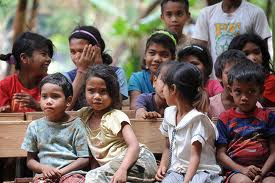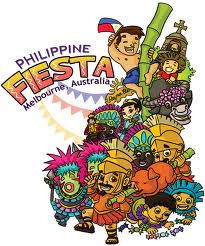Philippines People Culture - Our Values Tradition and History
To know our country, let me take you in time talking about Philippines people culture tradition and values.
It's what we call Philippine history - rich and precious to us, Pinoys.
Let us create a vision for you to be able to see through our eyes as we reveal what we are all about as Filipinos with our native tongue spoken language as Tagalog / Filipino.
|
The picture on the right describes how close the people are, the Pinoys. Look at the faces, the children and their dress. |
 |
Philippine History - Short Glimpse of Philippines People Culture and Influence
Portuguese Conquest by Ferdinand Magellan
Even long before Portuguese, Ferdinand Magellan said to have discovered the Philippines in March 16, 1521 when he set foot in Homonhon Island, Samar, we already have our oldest ancestors believed to be the Negritos who came some 30,000 years ago. This is when our first Philippines people culture was actually established.
The Malay Race and Our Muslim Native
It is believed that these first native Filipinos were the first ones to set foot through makeshift sailboat from rafts to the first old boats or probably a "balsa" roaming in the sea looking for land, shelter and food. These people were believed to have come from the neighboring islands of Sumatra, Malaya and Borneo which gave us our oldest existing race, the Malay race.
Our Muslim Philippines people culture as we now believe may be attributed to visits from 14th century Malay and Borneo Arab traders. Its date stretch back as far as the Southernmost Philippines, now Mindanao.
First Philippines Name
While very few would know more of Philippines people culture, it was Ruy Lopez de Villalobos, an explorer from Spain who actually gave our country one of its first names - FELIPINAS which actually came from the name of the son of CARLOS 1 named, PRINCE FELIPE 2.
Spanish Conquest by Miguel Lopez de Legaspi
The Spanish navigator and governor, Miguel Lopez de Legaspi, being the first believed Spanish conquistador had our country on his control back in 1564 and it wasn't until 1571 when Manila was made into a city of the Philippines by the same navigator. All these conquests were due to the strong trade presence for spice and the warring factions from Portuguese and Spanish conquerors led to small battles and discover of more islands to rule.
Chinese Conquest through Limahong
3 years later in 1574, another navigator, the Chinese pirate, Limahong revolutionized the establishment of Chinese colonial period, an important part of Philippines people culture. Even before that time, Chinese trade with who is believed to be the first Filipinos were already strong but interests on rich land as the Philippines became stronger as different navigators set hold in the island through galleons and pirate ships and trade ships and boats. This is the galleon trade, a trade and war for spices for which the island is rich of.
What Filipino People Love
Family
We love the concept of family. Proof to this is the fact that most Pinoys even if they no longer live in the country still choose to live together as family in harmony making free calls to the Philippines to chit chat with relatives. Married siblings love to stay in the same house with their parents living together and taking care of one another sharing food, shelter and showing love in everyday living. the young use "po" and "opo" in show of respect which many countries do not have or use as part of their native dialect - it is unique to Pinoys only.
Keeping the family intact as part of Philippines people culture is the fact that it is still being practiced today (which may be a bit feudal in nature) in many provinces and rural areas that only the father (tatay) of the house works outside while mothers (nanay) stay at home taking care of the kids helping them grow in strict Filipino values while doing all the household chores and trying to teach siblings how to do it at the right age.
Tradition and Fiesta as Part of Philippines People Culture
 |
Special mention to Jepoykalboh.deviantart.com for the photo of Philippine Fiestas. It really is more fun in the Philippines with this nice picture that describes part of our tradition as Philippines people. |
Part of what the Philippines people culture got from the Spaniards during Spanish colonial era is the love of celebration of diverse occasion, wedding traditions and fiestas. Since then, Filipinos have chosen to get indebted in loans and borrowing money from rich neighbors just to have something to offer in the dining table for visitors during local fiesta celebration. Whole year through, we celebrate these feasts with bountiful food as a sign of blessings and we dance and sing in karaoke (of today) in streets.
Characterized by local Filipino dishes / food on the dining table, each house without you knowing anybody living in it will try to invite strangers and visitors alike to come eat and try what they have on the table and probably drink a shot glass or two of the local beer - San Miguel Beer or in provinces, the local wine called "lambanog" or "tuba" (naturally fermented coconut flower sap or resin).
Festivals In Philippines (Alphabetical Order):
- Apribada -- Donsol, Sorsogon -- 4th week of January
- Arya! Abra Festival -- Abra -- March
- Ati-atihan Kalibo -- Aklan -- 3rd weekend of January
- Bayluhay Festival -- San Joaquin, Iloilo -- 3rd Saturday of January
- Black Nazarene -- Quiapo, Manila -- January 9
- Biniray - Romblon - January 9
- Bonok-Bonok Festival -- Surigao -- September
- Carabao Festival San Isidro, Nueva Ecija; Pulilan, Bulacan; Angono, Rizal May 15
- Caracol sa Makati -- Makati City, Manila -- last Sunday in January
- Catandungan Festival Catanduanes October
- Chinese New Year Chinatowns Late January or early February
- Cutud Lenten Rites San Fernando, Pampanga April
- Daro Sinulog - Dumaguete, Negros Oriental - 3rd week of January
- Dia de Zamboanga Festival Zamboanga City February 26
- Dinagyang Iloilo City 4th Sunday of January
- EDSA Day -- Mandaluyong City -- February 25
- Flores de Mayo Nationwide Month of May
- Festival of Hearts -- Tanjay City, Negros Oriental -- February 14
- Grand Cordillera Festival Baguio City November
- Helubong Festival Lake Sebu, South Cotobato Second week of November
- Hot Air Balloon -- Clark Subic, Zambales -- February 9-12
- Ibalong Festival Albay Second week of October
- International Bamboo Organ Festival Las Piñas Church February 15 to 25
- Kaamulan Festival Malaybalay, Bukidnon Late February to early March
- Kadayawan sa Dabaw Festival Davao City 3rd week of August
- Kagayhaan Festival Cagayan de Oro August 28
- Kahimonan Abayan Festival Butuan City July
- Kalilangan Festival -- General Santos City -- 4th week of February
- Kansilay Festival Silay City, Negros Occidental November 5 - 13
- Kinabayo Festival Dapitan City July 24
- Lantern Festival San Fernando, Pampanga December 24
- Lanzones Festival Camiguin October25-28
- Lingayen Gulf Landing - January 9
- Lubli-Lubi Festival Calubia, Leyte August 15
- Maradjao Karadjao Festival Surigao City September
- MassKara Festival Bacolod City Third weekend of October
- Misa de Gallo Nationwide Starts December 16
- Moriones Festival Boac, Mogpog & Gasal, Marinduque Holy Week
- Mudpack Festival Murcia, Negros Occidental June 24
- Our Lady of Candles Festival Jara, Iloilo February 2
- Pagoda Festival Bocaue, Bulacan July
- Pahiyas sa Quezon Sariaya, Lucban, Tayabas in Quezon May 15
- Palo-Palo Festival Batanes August
- Pamulinawen Festival Laoag City, Ilocos Norte February
- Parada ng Lechon Balayan, Batangas June 24
- Peñafrancia Festival Naga City, Camarines Sur 3rd Saturday of September
- Panagbenga (Baguio Flower Festival) Baguio Flower Festival Late February - Early March
- Piat Sambali Festival Cagayan Last week of June
- Pilgrimage on a Caravan La Union, Pangasinan Lenten Month
- Pintados-Kasadyaan Festival Tacloban, Leyte June 29
- Pinta Flores Festival San Carlos City 3-5 November 3-5
- Pinyahan sa Dael Daet, Camarines Norte June 15-24
- Sagayan Festival Tubod, Lanao del Norte First week of July
- San Clemente Higantes Festival Angono, Rizal November 23
- Sandugo Festival Tagbilaran City July 1-2
- San Fernando, La Union Festival -- La Union -- February 7-10
- Santacruzan Nationwide Month of May
- Sarakiki Hadang Festival Calbayog City, Samar September 7
- Sayaw sa Obando Obando May 17, 18, and 19
- Shariff Kabunsuan Festival Cotabato City Third week of December
- Sinukwan Festival San Fernando, Pampanga Early December
- Sinulog Cebu City, Cebu 3rd Sunday of January
- Sinulog de Tanjay Festival Tanjay, Negros Oriental July
- Suman Festival -- Baler, Aurora Quezon Province -- 3rd Week of February
- Sumbali Festival Bayombong, Nueva Viscaya A Week in August
- Taong Putik Festival Aliaga, Nueva Ecija June 24
- Tawo-Tawo Festival -- Bayawan City -- February 17
- T'boli Tribal Festival Lake Sebu, South Cotobato September
- Tinagba Festival Iriga City, Camarines Sur February 11
- Turumba Festival Pakil, Laguna Week before Holy Week
- Vigan Town Fiesta -- Vigan Ilocos -- January 25
- Zamboanga La Hermosa Festival Zamboanga City October 1-12
- Zambulawan Festival Pagadian, Zamboanga del Sur 3rd Sunday of January
Language of the Philippines People - Literature and Basic Tagalog to English Translation Tools
Literature history is rich in our country. This is because we believe language is basic for Philippines people culture. If you want to follow the rule of thumb in visiting places like the Philippines here's what you have to understand - as the saying goes, "when in Rome, do as the Romans do". So when in Philippines, you should learn to speak Tagalog. Therefore it is a must at least to learn basic Filipino language to enjoy more than what tripping benefits are waiting for you but the beauty of our smile of appreciation.
If you may, there are plenty of ways to learn common Filipino phrases. One is to hire yourself a Tagalog translator or get yourself an online help via word translator programs by Firefox or Google used as browser plugins. Learning early in advance will always yield better travel experience anywhere you go.
You may also opt in to buy yourself a cheap Tagalog English dictionary. In this case, it is advisable to get it from National Bookstore, a trusted center for educational and language translation resources in the form of pocket sized books of small varieties. A local map of the place you want to visit would also be handy so buy one too.
Otherwise, if you are an online geek with an android phone and you want to do it in today's mobile apps review world using your cellphone, you can always download your Philippines people culture helper when it comes to learning how to speak Tagalog - the free android mobile app from Google Play App store - English Tagalog Dictionary here or you may opt in for Google Translate. A great choice if you are looking to travel Philippines is to hire a tour guide who is known and qualified to be a good Filipino translator and knows English translation not by the book but by phrase. A knowledge of the travel places is definitely a plus factor.
Languages Spoken
In Wikipedia, it states that the Philippines people culture is diverse due to a range of about 171 native languages or dialects that Pinoys speak and this does not include English, Spanish, Hokkien (Lan-nang), Cantonese, Mandarin, and Chavacano. We will list the 13 major ones later below for reference.
Different countries have different languages that they speak. Philippines have one of the most diverse multiple languages while we have a history that is rich from our different Philippine presidents era and even before to contribute to Philippine history.
13 Indigenous Languages
|
15 Presidents of the Philippines
|
Filipino Recipe - List of Favorite Philippine Food
Some of our personal favorite in the family are those cooked by Rosebud Benitez, the chef mom from the program Quickfire Recipes (10-minute cooking) in QTV back a few years ago. Although with respect to Filipino recipe, we must speak in general so let us open up the plate and menu for all of you to see how visitors in our country love eating common easy Filipino recipes to cook. We have quite a list that never runs out of getting laid in the Philippines people dining table in every tradition and fiesta celebration. The list below are only some of our family's favorites.
For the ingredients, how to cook procedures and other recipe specific details, please navigate or click on each recipe link. Indulge and enjoy eating.
Dessert Recipes
|
Soup Recipes
|
Salad Recipes
|
Pasta Recipes
|
Pork Recipes
|
Vegetable Recipes
|
Cocktail
|
Chinese Inspired
|
Beef Recipes
|
Seafood Recipes
|
Chicken Recipes
|
Egg Recipes
|
Philippine National Heroes List
Filipinos love and honor their heroes. We have a big list of these wonderful Philippines people we owe part of our national heritage and culture from. We have native Pinoys as well as diversified race from Spanish, Japanese, American, Chinese and our majority which is of Malay nature. We celebrate many national heroes day like that of the part Spanish part Pinoy, Jose Rizal who happens to be our official national hero (pambansang bayani). We recognize the bravery of Gat Andres Bonifacio leading the Katipunan in his time. His day is also celebrated as Bonifacio Day which is November 30 while Rizal Day is celebrated December 30.
- Dr. Jose Rizal - The Philippines National Hero.
- Andres Bonifacio - The Great Revolutionary Plebian and Father of the Katipunan (KKK).
- General Gregorio del Pilar - Hero of the Battle of Tirad Pass.
- General Emilio Aguinaldo - President of the First Philippine Republic.
- Apolinario Mabini - Sublime Paralytic and Brain of the Revolution.
- GOMBURZA - Martyred Priests of 1872 - Father Gomez, Burgos and Zamora.
- Trece Martirez - 13 Martyrs from Cavite.
- Emilio Jacinto - Brain of the Katipunan.
- General Antonio Luna - Cofounder of La Independencia.
- Melchora Aquino (Tandang Sora) - Mother of Balintawak and Grand Woman of the Revolution.
- Graciano Lopez-Jaena - Greatest Filipino Orator of the Propaganda Movement.
- Panday Pira - First Filipino Cannon-maker.
- Mariano Ponce - Propagandist, Historian, Diplomat And Managing Editor of La Solidaridad.
- Gregoria de Jesus - Lakambini of Katipunan and Wife of Andres Bonifacio.
- Fernando Ma. Guerrero - Poet of the Revolution.
- Felipe Agoncillo - Outstanding Diplomat of the First Philippine Republic.
- Rafael Palma - Cofounder of La Independencia and First UP president.
- Juan Luna - Greatest Filipino Painter.
- Marcelo H. Del Pilar - Greatest Journalist and Moving Spirit of the Propaganda Movement.
- Leona Florentino - First Filipino Poetess(from Ilocos Sur).
- Pedro Paterno - Peacemaker of the Revolution.
- Isabelo delos Reyes - Founder of Philippine Socialism.
- Artemio Ricarte - Revolutionary General, known as Viborra.
- Jose Palma - Wrote the Spanish Lyrics of the Philippine National Anthem.
- Lakandula - Chief of Tondo, Friendly to the Spaniards.
- Rajah Soliman - The Last Rajah of Manila.
- Leonor Rivera - Cousin and Fiancee of Jose Rizal.
- Marcela Mariño Agoncillo - Maker of the First Filipino Flag.
- Galicano Apacible - One of the Founders of Katipunan.
- Jose Ma. Panganiban - Bicolandia's Greatest Contribution to the Historic Campaign for Reforms.
- Diego Silang - Leader of the Ilocano Revolt.
- Maria Josefa Gabriela Silang - Continued the Fight After her Husband's Death.
- Lapu-Lapu - Chieftain of Mactan Who Killed Magellan. First Filipino Hero.
- Francisco Dagohoy - Leader of the Longest Revolt in Bohol.
- Epifanio delos Santos - A Man of Many Talents; the Former Highway 54 is Now Named After him (EDSA).
- Francisco Baltazar - Prince of Tagalog Poets.
- Teresa Magbanua - First Woman Fighter in Panay. Visayan Joan of Arc.
- Trinidad Tecson - Mother of Biak-na-Bato.
- Agueda Esteban - Wife of Artemio Ricarte Who Carried Secret Messages About Spanish Troops.
- Marina Dizon - Daughter of One of the Trece Martirez.
- General Francisco Makabulos - Leader of the Revolt in Tarlac.
- Julian Felipe - Composer of the Philippine National Anthem.
Other parts of the republic where Philippines people culture and historical heritage include Philippines fashion, celebrities, costumes, museums, libraries, arts and event places. For proof on how diverse and widely covered the history of Philippines people is and to find more information, please navigate in About Philippines sidebar navigation.
"Visit our Online Store page in the sidebar."
Help our family maintain this site and spread the good news about organic farming and self sustainability in the Philippines.
Buy our products now!


